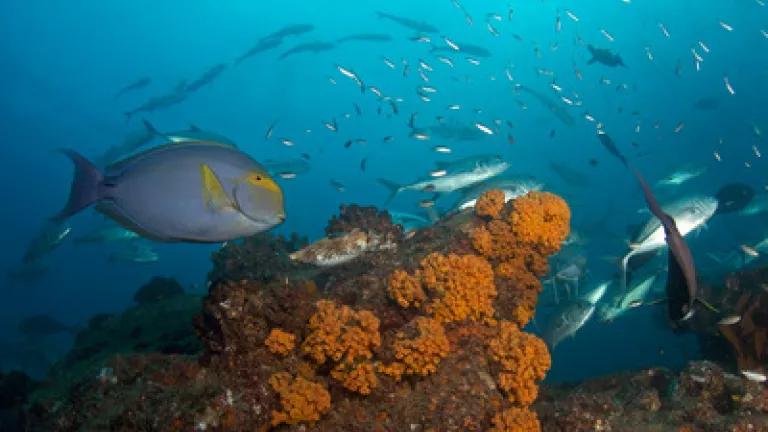
Climate change will leave little of the ocean untouched, according to a recent study that looked at projected changes in ocean temperature and biogeochemistry linked to carbon dioxide emissions. So what might a changing climate and ocean acidification mean for Mexico’s Cabo Pulmo National Park? Hailed as one of the world’s most robust marine reserves, Cabo Pulmo is home to possibly the most important coral reef in the American Pacific. Corals are sensitive to small increases in ocean temperature and acidity, making them some of the most vulnerable ecosystem to climate change. Encouragingly, the healthier corals are, the more resilient they may be to these changes. To keep the corals like the ones in Cabo Pulmo safe, it will be important to drastically cut the world’s greenhouse gas emissions. Yet it is also critical to adequately safeguard them from localized threats such as the proposed Cabo Cortés tourism and real-estate complex that that was cancelled last year.
Coral reefs are among the most diverse and productive ecosystems on the planet. Home to about a quarter of all marine species, these ‘rainforests of the sea’ play a key role in sustaining the breeding, spawning and feeding lifecycles of fish species that are critical for commercial fisheries and food security. Coral reefs also make important contributions to tourism industries around the world. For example, coral reef- and mangrove-associated tourism activities make up between 12 to 15 percent of the GDP in Belize.
Yet shallow water coral reefs are also among the most threatened ecosystems in the world. Their proximity to the coast makes them vulnerable to pollution, destructive fishing practices and unsustainable coastal development. Climate change and greenhouse gas emissions are now putting these critical ecosystems under even greater pressure by warming the ocean’s temperature and changing its chemical balance. Since coral species only thrive within narrow parameters of temperature and pH, changes to these factors can have a debilitating impact on their health:
- Warmer ocean temperatures contribute to coral degradation. Rising ocean temperatures are a key factor in coral bleaching – the loss of the microalgae that live in coral tissues and are the source of the organisms’ food and bright colors. While corals can sometimes recover from bleaching, some of these incidents can eventually result in coral death. Major coral bleaching has occurred when, within the period of a month, sea surface temperatures rose by 0.5–1o Celsius above a site’s average hottest temperatures. Bleaching associated with this degree of temperature increase can be reversible, but increases of 3o Celsius have resulted in coral mortality. Concern for rising ocean temperatures mounted in 2005 to 2006 when record-high temperatures in the Caribbean Ocean resulted in significant coral bleaching and mortality in most of the islands.
- Carbon dioxide emissions make the ocean more acidic. Each year the ocean absorbs about one fourth of all carbon dioxide emissions, a phenomenon that is increasingly changing the chemistry of the ocean. Greater ocean acidity reduces the level of carbonate, a substance that corals need to build their skeletons. Ocean acidification not only slows coral growth, it also makes the corals more brittle and less resilient to erosion. Increased ocean acidification may contribute to coral death if the corals erode at a faster rate than they can calcify.
As the recent study notes, a warmer and more acidic ocean could impact the role corals play in supporting fishery and tourism sectors worldwide. Fish stocks may suffer due to coral reef degradation and mortality, jeopardizing commercial fisheries as well as local and regional food sources. Coastal communities that rely on corals as a tourism attraction may also face serious ramifications.
Could this happen in Cabo Pulmo? Cabo Pulmo’s coral reef is a clear example of the vulnerability of corals – and their resilience when adequately protected from threats. After years of unsustainable fishing practices degraded Cabo Pulmo’s marine ecosystem, the creation of a protected area and concerted conservation efforts by the local community brought the reef back to life. In the first ten years since the park was created, marine life in the site recovered by an astonishing 463 percent. The fish biomass produced in the protected area may exceed US$ 60,000,000 in value. The reef now also sustains the eco-tourism based economy of the local Cabo Pulmo community, by one estimate yielding around USD 600,000 annually from diving and snorkeling activities. The healthy corals in the park may also be more resilient to the bleaching symptoms of climate change. Last year on a visit to Cabo Pulmo I heard from a local scientist who described how the robust corals in the marine reserve held up better during coral bleaching incidents in the Gulf of California. Yet, he too noted there could be a tipping point beyond which even Cabo Pulmo’s healthy corals would be unable to withstand ocean changes linked to global warming and greenhouse gas emissions.
To ensure that Cabo Pulmo’s corals continue to thrive over the long term, it is essential to minimize both local and global threats. Last year’s cancellation of the massive Cabo Cortés coastal tourism project was the right choice. Going forward, it is important for Mexico to continue to prioritize the reef’s conservation by avoiding high-impact, coastal development near the park. It is also critical to drastically cut the global greenhouse gas emissions that threaten the world’s corals. By doing so, hopefully, we won’t have to find out where the climate change tipping point is for Cabo Pulmo.
This post was co-written with Leah Germer, M.A. candidate at American University
Photo: Octavio Aburto

